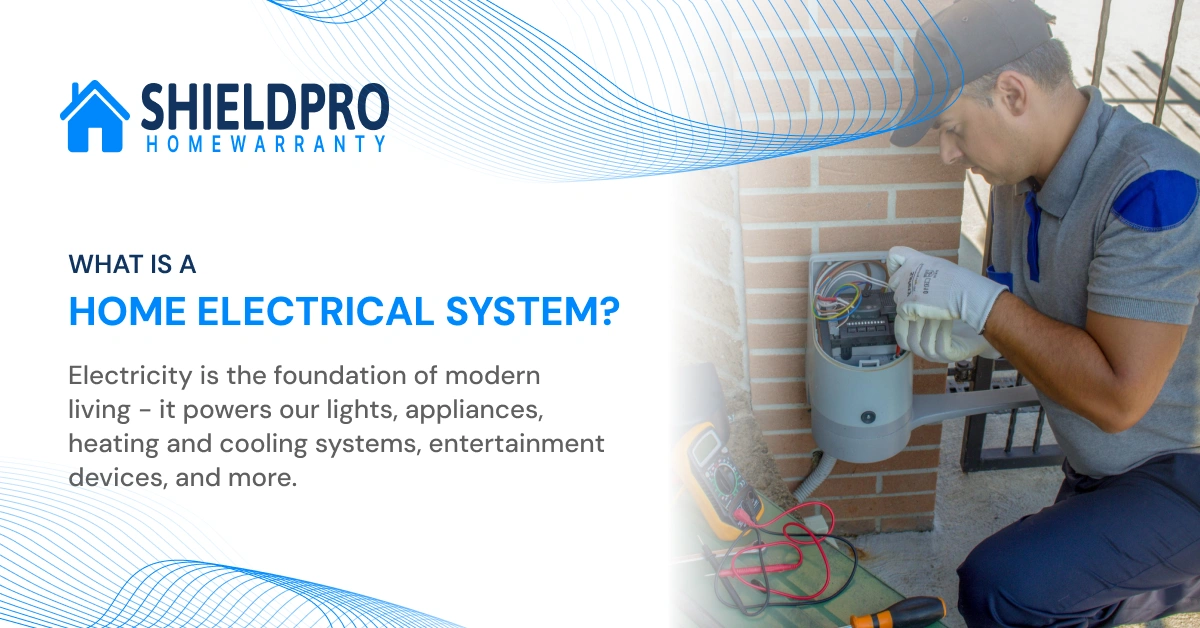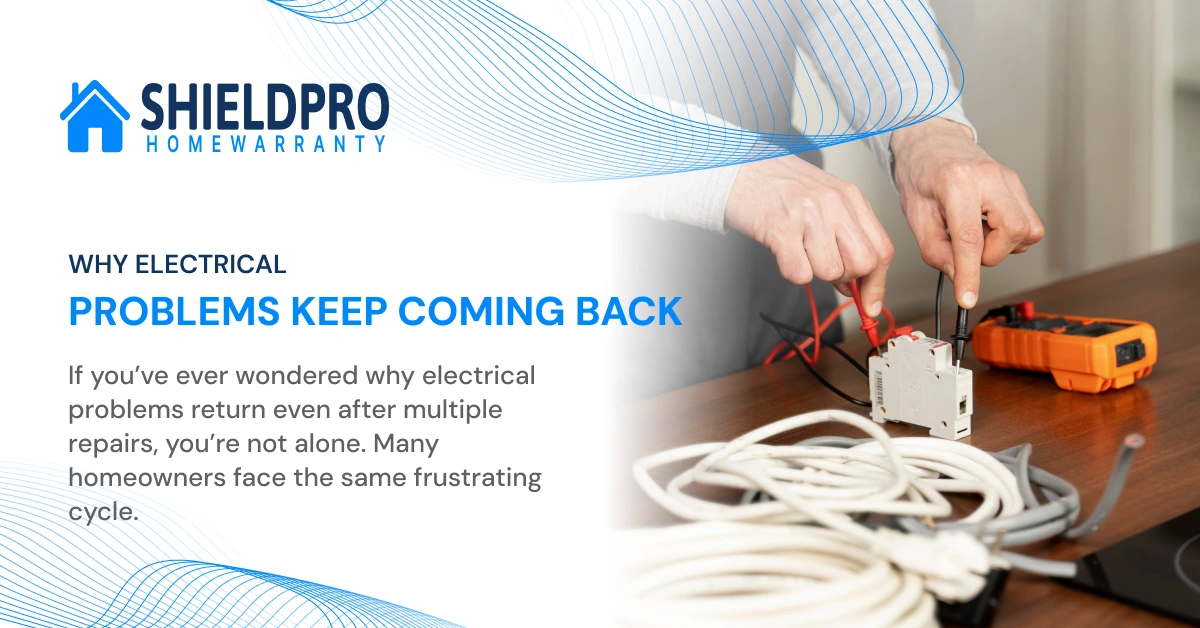
Electricity is the foundation of modern living, it powers our lights, appliances, heating and cooling systems, entertainment devices, and more. Yet, most homeowners rarely think about how this power flows safely through their homes until something goes wrong.
This guide offers a complete understanding of the home electrical system, how it works, the most common issues, the right ways to maintain it, and how a home warranty can protect you from unexpected repair costs.
Whether you’re a new homeowner or simply looking to upgrade your knowledge, this comprehensive guide will help you make informed, safe, and cost-effective decisions about your electrical setup.
Understanding the Home Electrical System
What Is a Home Electrical System?
Your home’s electrical system is the network that distributes power from the utility company to every switch, outlet, and appliance. It includes the main service line, breaker panel, wiring, outlets, switches, and safety components that protect your home from electrical hazards.
A properly installed and maintained system ensures safe power delivery, prevents overloads, and minimizes the risk of electrical fires or damage to appliances.
Key Components of an Electrical System
- Service Entrance: This is where electricity enters your home from the local power grid, usually through overhead or underground cables.
- Electric Meter: Measures the amount of electricity your home consumes.
- Main Breaker Panel: Also called a load center or fuse box, this panel divides electrical power into different branch circuits and contains breakers that shut off power if something goes wrong.
- Branch Circuits & Wiring: Wires distribute power from the breaker panel to outlets, switches, and fixtures throughout your home.
- Outlets and Switches: The access points that deliver power to your appliances and lighting.
- Grounding System: Provides a safe path for excess electrical current to travel back into the earth, protecting people and equipment from electric shock.
- Safety Devices: Includes circuit breakers, fuses, Ground Fault Circuit Interrupters (GFCI), and Arc Fault Circuit Interrupters (AFCI).
How the System Works
- Electricity flows from the utility line into your home’s meter, then to the main breaker panel.
- Inside the panel, power is divided into multiple branch circuits protected by circuit breakers.
- Each circuit distributes electricity through the home via insulated wiring, leading to outlets, switches, and appliances.
- If an overload or fault occurs, the breaker automatically trips to stop current flow and prevent damage or fire.
- Grounding ensures that any stray current is safely discharged into the earth rather than traveling through people or equipment.
A well-functioning electrical system maintains a steady power supply and reduces the risk of safety hazards.
Common Electrical Problems, Repairs, and Upgrades
Warning Signs of Electrical Issues
Ignoring early warning signs can lead to severe problems or even electrical fires. Look out for these indicators:
- Circuit breakers trip frequently
- Lights flicker when large appliances start
- Outlets or switches feel warm or smell burnt
- Buzzing or crackling sounds near outlets or panels
- Sparks when plugging in devices
- Outlets without GFCI protection in kitchens, bathrooms, or garages
- Persistent shocks when touching appliances
- Old fuse boxes instead of modern circuit breakers
Addressing these symptoms early can prevent costly repairs and improve your home’s safety.
Common Electrical Repairs
1. Circuit Breaker Replacement or Panel Upgrade
If your home still uses an old fuse box or has an undersized panel (60–100 amps), it might be time for an upgrade. Modern homes typically need at least 200-amp service to handle today’s electrical demands. Replacing or upgrading a panel can cost anywhere from a few hundred to several thousand dollars, depending on size and complexity.
2. Rewiring
Older homes often contain outdated or deteriorated wiring that cannot handle modern loads. Rewiring improves safety, prevents overheating, and reduces the risk of fire.
3. Outlet and Switch Replacement
Worn or damaged outlets can lead to arcing, which generates heat and poses fire risks. Installing GFCI and AFCI outlets adds essential safety protection.
4. Surge Protection
Installing whole-home surge protectors shields your electrical system and appliances from sudden voltage spikes caused by lightning or power surges.
5. Dedicated Circuits for Heavy Appliances
Appliances such as refrigerators, washing machines, and HVAC units should have their own dedicated circuits to prevent overloading.
Electrical Upgrades for Modern Homes
Modern electrical systems can include advanced features that improve energy efficiency and convenience:
- Smart Panels: Allow homeowners to monitor and manage electricity usage through mobile apps.
- Energy-Efficient Lighting: Upgrading to LED lighting reduces energy consumption and heat output.
- Motion Sensors and Smart Switches: Automate lighting and reduce unnecessary energy use.
- Whole-Home Surge Protection: Prevents damage from unexpected voltage spikes.
- Labeled Circuits: Proper labeling helps identify which breaker controls which area, making maintenance safer and faster.
Upgrading your electrical infrastructure not only enhances performance but also adds value to your property.
Electrical Maintenance and Safety Practices
Routine Maintenance Tips
Keeping your electrical system in good condition doesn’t require advanced expertise, just consistent attention:
- Inspect your breaker panel for dust, corrosion, or loose wires.
- Test GFCI outlets monthly by pressing the “Test” and “Reset” buttons.
- Keep the panel area clear of storage items for easy access.
- Ensure all outlets and switches are cool to the touch and functioning properly.
- Replace frayed cords or damaged plugs immediately.
- Label breakers in the panel clearly.
- Avoid using extension cords as permanent wiring solutions.
Regular checks reduce the chance of system overloads and fire hazards.
When to Call a Professional
Certain electrical tasks should always be handled by a licensed electrician. Seek professional help if:
- Breakers trip repeatedly for no clear reason.
- You experience burning odors or visible sparks.
- Outlets or switches show burn marks or discoloration.
- You plan to install new major appliances or increase power demand.
- Your home is more than 20 years old and has never been inspected.
Professional inspections every 3–5 years ensure that your wiring, grounding, and breakers meet current electrical codes.
Electrical Safety Best Practices
- Always turn off power at the main breaker before handling any wiring.
- Never touch wet surfaces while working with electricity.
- Keep flammable materials away from electrical panels and cords.
- Avoid overloading outlets or using power strips for high-load devices.
- Ensure grounding connections are intact, especially after major repairs.
- Use only approved electrical materials and certified components.
Safety should be your first priority when dealing with electrical systems.
Electrical System Warranty and Protection Coverage
What an Electrical Warranty Covers
A home warranty or protection plan can help offset the cost of repairing or replacing major electrical components when they fail from normal wear and tear. Typical coverage may include:
- Electrical panels and breakers
- Interior wiring
- Switches and outlets
- Junction boxes and connectors
- GFCI and AFCI protection devices
Warranty coverage ensures that when an electrical issue arises, you only pay a small service fee instead of the full repair cost.
Common Exclusions to Understand
Home warranties may not cover:
- Pre-existing issues or code violations
- Damages caused by misuse or neglect
- Upgrades to meet new electrical codes
- Outdoor or detached structure wiring
- Modifications required for remodels or expansions
Always read the policy carefully to understand limitations and avoid unexpected expenses.
How to Choose the Right Plan
When evaluating home warranty providers or protection plans, consider:
- Coverage Scope: Confirm that key electrical components are included.
- Claim Process: Ensure claims are simple, with quick response times.
- Technician Network: Verify that the company uses licensed electricians.
- Deductibles and Fees: Compare service call fees and annual premiums.
- Customer Support: Look for 24/7 assistance and transparent terms.
Choosing the right plan can save hundreds or even thousands of dollars in unexpected electrical repairs.
Aligning Maintenance with Warranty Coverage
To get the most out of your warranty plan:
- Keep maintenance records and inspection receipts.
- Fix minor issues before they cause larger system failures.
- Maintain clear access to the electrical panel.
- Use approved parts when making repairs.
- Report electrical issues immediately — delays may void coverage.
A proactive maintenance approach ensures that your warranty remains valid and effective.
Case Study: Electrical System Upgrade and Warranty in Action
Scenario:
A homeowner in a 25-year-old house noticed frequent breaker trips whenever the air conditioner and microwave operated simultaneously.
Diagnosis:
An electrician found that the 100-amp panel was undersized for the current electrical load, and several circuits were overloaded.
Solution:
The homeowner upgraded to a 200-amp service panel, rewired high-demand circuits, and installed whole-home surge protection. They also purchased a home electrical warranty covering the new panel and internal wiring.
Outcome:
Within two years, one circuit failed due to a breaker defect, and the warranty covered the full replacement cost. The homeowner saved hundreds of dollars and gained long-term peace of mind.
Key Takeaways and Action Plan
Main Lessons
- A home electrical system consists of the service entrance, panel, circuits, wiring, outlets, and safety devices that keep power flowing safely.
- Regular inspection and maintenance are essential to prevent hazards and ensure efficiency.
- Upgrading outdated systems improves performance and safety.
- A home warranty can significantly reduce out-of-pocket costs for unexpected repairs.
- Always rely on licensed professionals for major electrical work.
Actionable Steps
- Inspect your breaker panel and outlets for any visible damage.
- Test GFCI outlets in kitchens and bathrooms monthly.
- Label circuits clearly in the breaker box.
- Avoid overloading outlets or using daisy-chained extension cords.
- Schedule an electrician inspection every 3–5 years.
- Review and compare home electrical protection plans to secure coverage.
Following these steps ensures long-term reliability and safety for your entire electrical system.
Conclusion
Your home’s electrical system is one of its most critical yet overlooked elements. A properly maintained and protected system not only keeps your household running smoothly but also safeguards your family and property from electrical hazards.
By understanding how your system works, identifying potential issues early, performing regular maintenance, and investing in a suitable home warranty, you can enjoy consistent performance, reduce repair costs, and extend the lifespan of your entire electrical network.
Read More:
Do Home Warranties Cover Electrical Problems?
Why Electrical Problems Keep Coming Back Even After Repairs?








